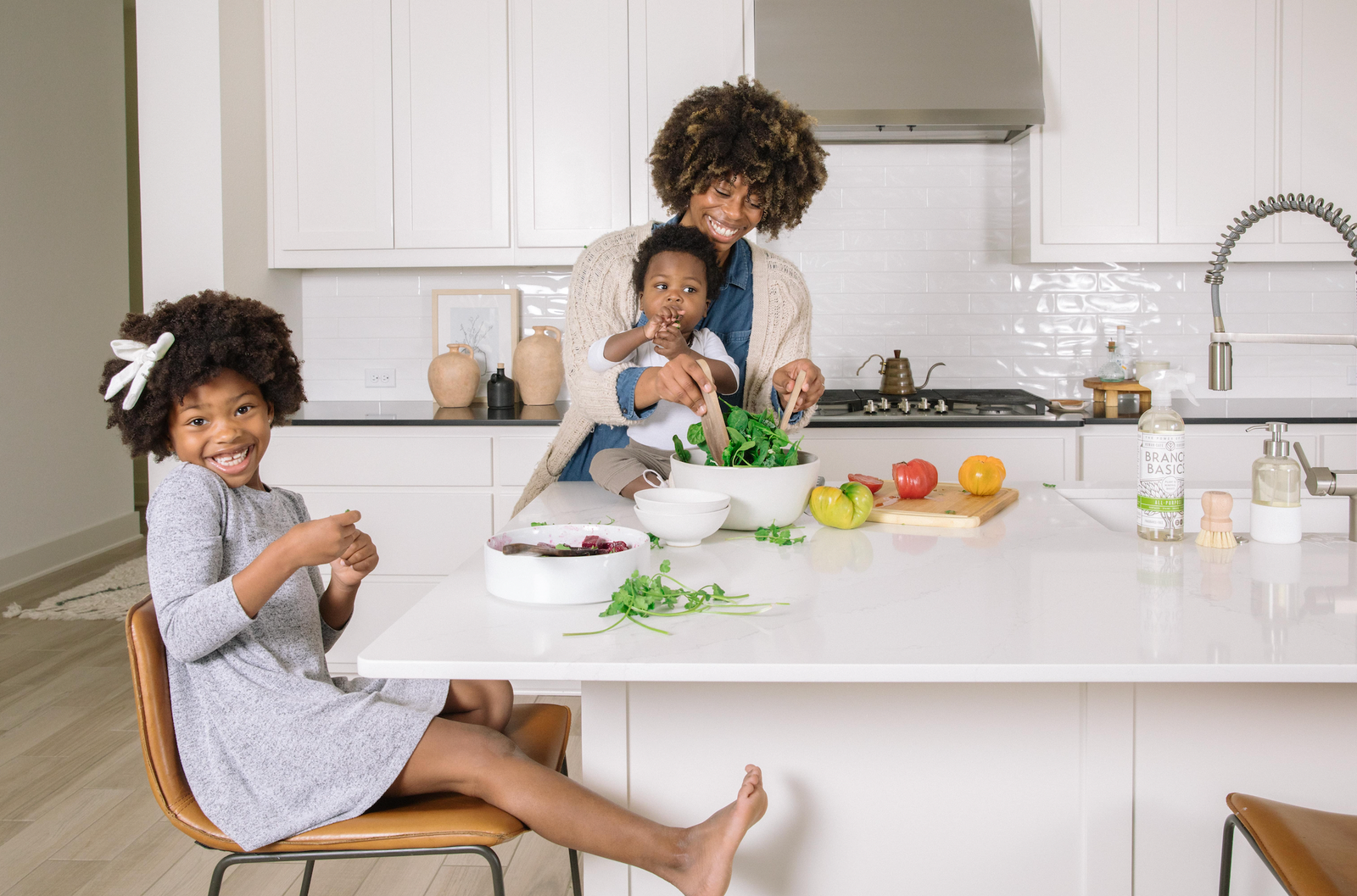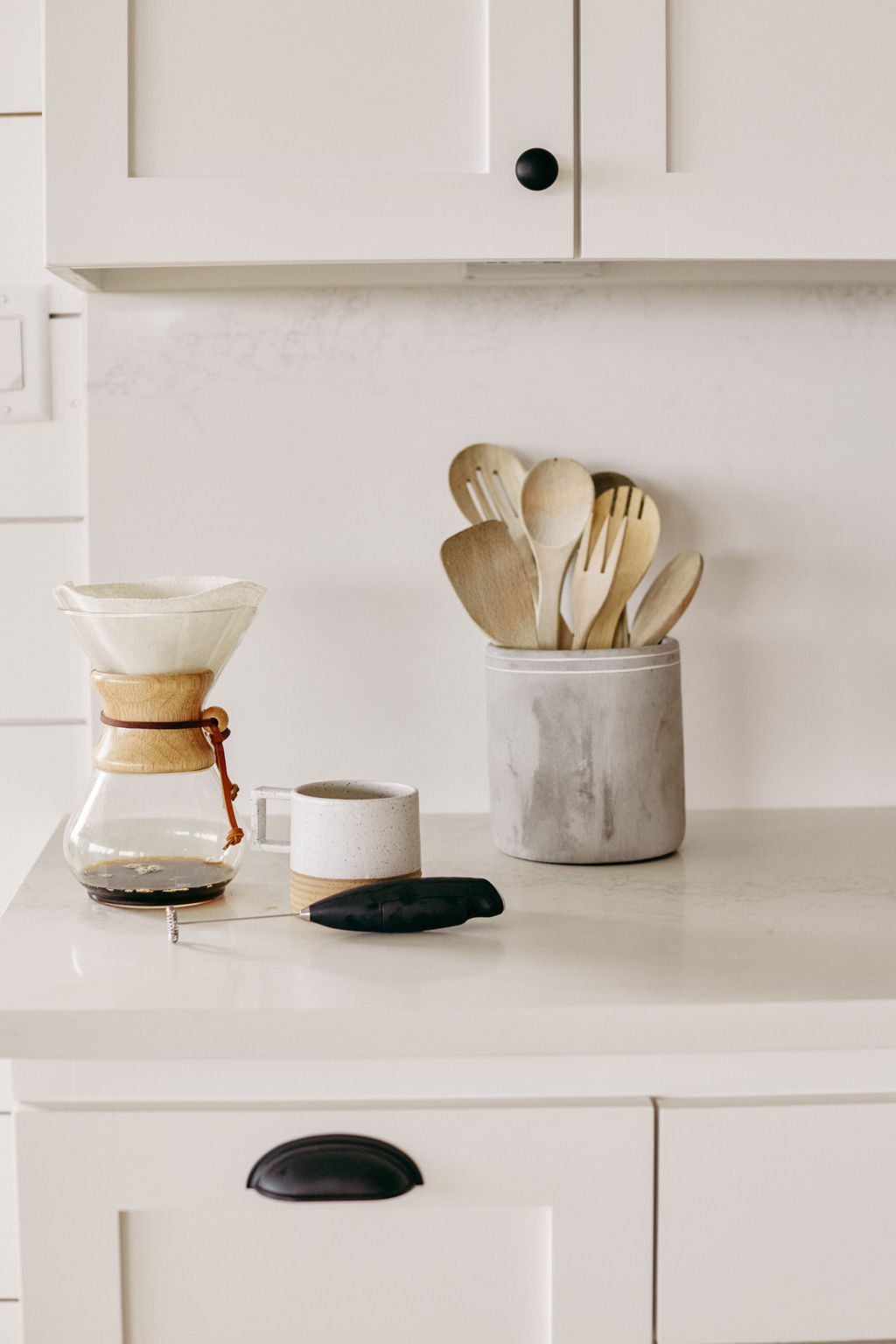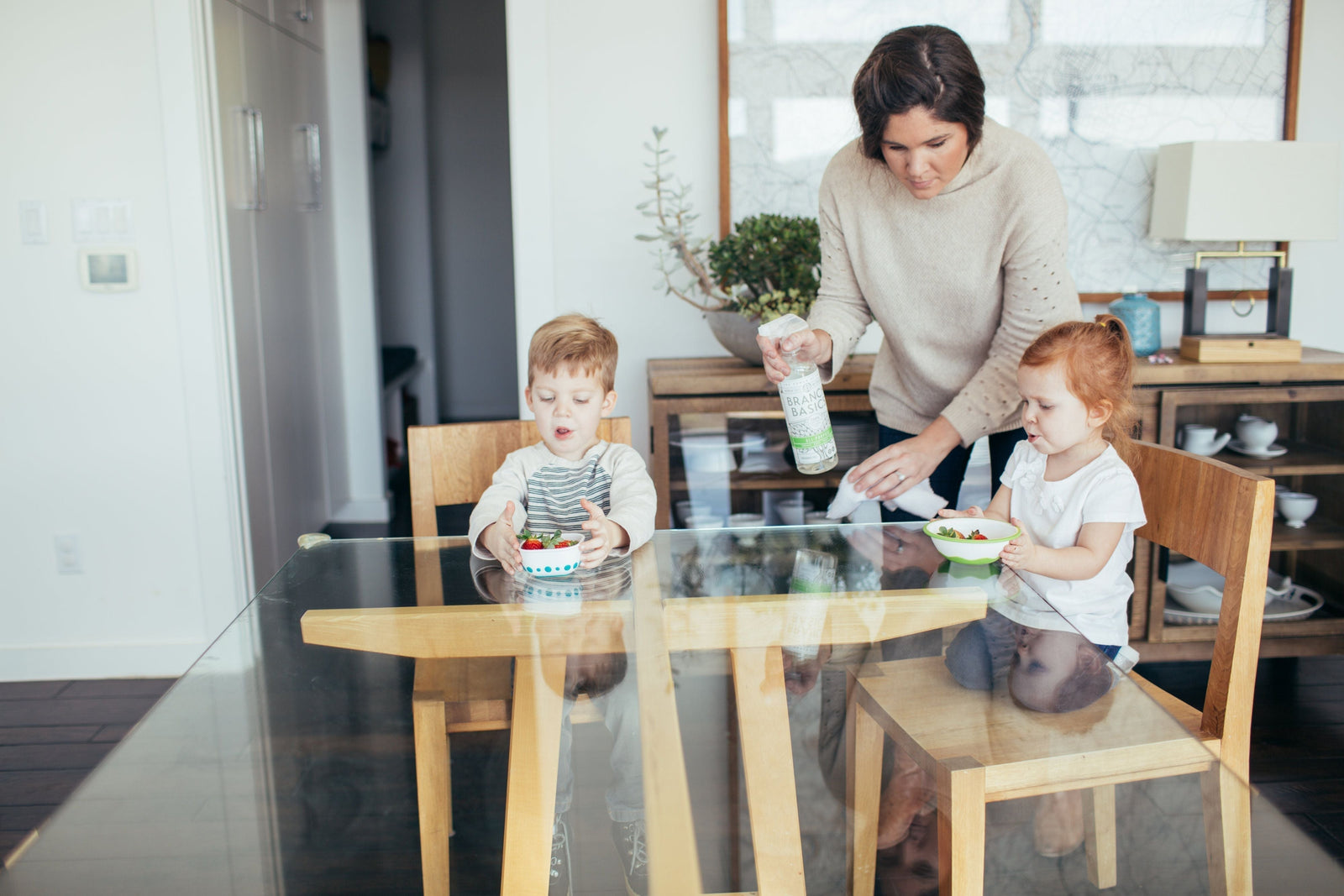7 Tips for Fast, Real-Food, Healthy Home Cooking

It may sound obvious, but one of the best ways to toss the toxins is to cook real, nutritious, organic meals at home as often as possible. In doing so, you’ll consume more beneficial fresh, whole foods and avoid inflammatory oils, sugar, preservatives, additives and more.
Trust me, I know how convenient it is to pick up food or go out to eat - I mindfully do that with my family at least once a week - but oftentimes the convenience of eating out can actually make our lives harder, more stressful and less enjoyable because of the impact food has on our physical, mental and emotional health.
Here are 7 tips that help simplify cooking at home so you can have wholesome breakfasts, lunches, dinners and snacks regularly.
While it can take a little planning and adjusting to get used to cooking more, the empowerment, health and environmental benefits are well worth the effort. Plus, you’ll be modeling excellent lifelong habits for children if little ones are in the home.
Tip #1: Meal Plan Weekly or Monthly
Meal planning is extremely helpful for executing efficient homemade meals without expending the daily mental energy thinking about what to cook for dinner. Once you have your system down, meal planning can be quick and simple.
To get the most out of meal planning, plan an entire week or month’s worth of meals on a weekend or your day off. If you do a month at a time, you can simply repeat the month over and over.
This strategy works well if you’re a family with young kids who like consistency, but it works to do it weekly too and add in more variety. Either way, you can always sprinkle in new recipes you come across and want to try.
There are endless meal planning and grocery list apps, downloads, calendars, and systems you can try based on your organization style.
Some bloggers and nutrition experts even have pre-done meal plans, with recipes and grocery lists, you can purchase (Wellness Mama, 100 Days Of Real Food are good examples).
For simplicity's sake (and to reduce screen time), a physical family calendar—like this — is great to write down a month’s worth of meals. You can also use a big blackboard in the kitchen to jot down the weekly menu so everyone can see (and help out). Try out a few different options to see what suits you best.
Also, keep in mind that a meal plan is just a plan. Meaning, it can be adjusted and tweaked based on your family’s needs…or what you may have forgotten at the grocery store or farmer’s market, for the week.
Tip #2: Buy Pre-Made Whenever Possible
We do not cook everything from scratch! When Marilee began her healing journey several decades ago, almost everything had to be cooked at home.
Thankfully today, there are many wonderful pre-made foods with real, organic ingredients you can buy in sustainable packaging. But the details count, especially if you’re healing, have an auto-immune disease, chronic illness, or food sensitivities.
The primary things to look for are:
- Organic (especially for meat, dairy + The Dirty Dozen)
- No Genetically Modified (GMO) Ingredients
- No refined sugar
- No excitotoxins (see our list)
- No inflammatory oils (learn more here)
- No artificial ingredients/flavors/dyes/preservatives (including “natural flavor”)
- No citric and ascorbic Acid
- No refined salt
Get more details in: Toss the Toxins in Your Pantry and Refrigerator.
A few of our favorite organic food brands include:
- Primal Kitchen (condiments, dressings, snacks)
- Frontier Organic Spices
- Riega Foods taco seasonings
- Ancient Harvest & Lotus Foods (GF pastas)
- Lundberg Organic (rice)
- DeBoles Organic Jerusalem Artichoke Pastas
- Organico Bello and Eden Foods (spaghetti sauces)
- Jovial & Bionaturae (tomatoes + tomato paste in glass)
- Force of Nature, Primal Pastures and Reil Ranch pasture-raised organic meats, fish, and poultry
- SafeCatch and Vital Seafood for fish & seafood
- Bilinski’s Chicken Sausage
- Hu Grain-Free, Mary’s Gone Crackers & Flackers (crackers)
- Food for Life Organic Sprouted Corn Tortillas
- Eden Foods (sauerkraut + canned beans)
- Malk Organics (nut milks)
- AWG Bakery gluten-free bread
- Brodo Broth Co and Fond (bone broths)
- Yellowbird sauces
Tip #3: Double (Or Triple) Up Recipes When You Can
This is one of the best time-savers you will ever implement!
Whenever you’re cooking something that will freeze well, such as meatloaf, pasta sauce, casseroles, stews, soups, burgers, meatballs, lasagna, salmon or tuna patties, muffins, etc., double or triple the recipe, and freeze what you don’t use for another time.
Then all you have to do is pull out your extra meal, pop it in the oven or on the stove and put together a salad and/or quick veggie like steamed green beans or broccoli. Super easy and healthy.
Tip #4: Put Your InstantPot To Work
The InstantPot could be the best new kitchen appliance of the century! If you haven’t bought one, or if you have one but haven’t learned to use it, now is the time.
It’s essentially a pressure cooker that’s really easy to use and can cook almost anything from meatloaf and mashed potatoes to fruit cobbler, cakes, and even a whole “roasted” chicken.
It’s also incredible for quick-cooking beans, whole grains, and low-glutamate bone broths, as a slow cooker, and some models can be used as yogurt makers, air fryers, and sterilizers.
One caveat: as Marilee mentions in How to Cook for Optimal Nutrition, it’s important not to rely on your InstantPot exclusively and to incorporate a variety of other cooking methods (steaming, stir frying, roasting, and broiling are all great healthy and speedy methods).
Tip #5: Batch Cook When You Can
We realize this isn’t for everyone. But if you have a few hours you can block out on a weekend or day off, batch cooking can save you a ton of time on weeknights.
I like to bake/roast a bunch of veggies tossed in avocado oil and sea salt that we can make bowls out of or have as a side with fresh fish or a meat dish.
I usually cut up sweet potatoes, red potatoes, beets, butternut squash, yellow squash, zucchini, onions and garlic separated into sections in a few glass Pyrex dishes or cookie sheets.
I also like to saute mushrooms and Brussels sprouts on the stove while those are in the oven.
In order to maintain the integrity and nutritional value of the food, it’s good to keep these 5 batch-cooking/meal prep recommendations in mind:
- In general, avoid pre-cutting/pre-slicing all your vegetables for the week if not cooking until days later. Once fresh veggies are cut, they can lose valuable nutrients. That said, be flexible here because it’s much better to eat your veggies period than not because you don’t have time to prep them last minute. But if you can, try to cut them just before cooking.
- A few exceptions are:
- Prepping lettuce, in which the whole leaves can be broken off the head, washed, stored in mason jars or with unbleached paper towels in silicone bags, then quickly chopped up or torn just before serving.
- Pre-cutting veggies to munch on (because this ensures you’ll actually eat them). Simply store them in filtered water in mason jars in the fridge.
- Trimming asparagus ends to store in water, which preserves their freshness.
- Avoid storing food in plastic containers or bags which leach chemicals into food. Instead, opt for Pyrex, glass storage containers, mason jars, or high-quality silicone bags.
- While batch-cooking and freezing some meals for easy weeknight prep is great, try not to rely on freezer meals exclusively as nutrients are lost in the freezer.
- If you pre-cook a dish on the weekend then reheat it during the week, just heat up the amount you’re going to eat. It’s not ideal to reheat it twice for leftovers; for both food safety and nutrient density reasons.
- Reheat batch-cooked meals in the oven or toaster oven, on the stovetop, or in a non-non-stick air fryer (like this glass one or a stainless steel toaster oven-style air fryer). We do not recommend using a microwave as they are a source of RF (radio frequency) exposure and have been shown to degrade food quality.
Get more tips for prepping your produce to save money and waste in: How to Keep Fresh Produce Fresher Longer.
And check out one of our favorite books on the topic: Cook Once, Eat All Week: 26 Weeks of Gluten-Free, Affordable Meal Prep to Preserve Your Time & Sanity.
Tip #6: Soak Beans And Grains The Night Before, Then InstantPot Them
Sadly, most canned foods contain can liners made with BPA, a hormone disrupting chemical that leaches into the food.
Even if you see “BPA-free” listed on the label, unfortunately, BPA has been substituted with another hormone-disrupting bisphenol chemical like BPS or BPF. We love Eden Foods because they use cans lined with a non-toxic resin.
For this reason, we opt for foods sold in glass, Eden canned foods, or just cook our own.
The InstantPot has made cooking dried beans a cinch. Just soak overnight in water to cover with 1 tablespoon of lemon juice. Pour off soaking water and cook according to the Instant Pot directions.
It’s convenient to cook a triple batch and freeze them in glass or silicone bags for future needs.
It’s also beneficial to soak whole gluten-free grains overnight in water to cover plus 1 tablespoon lemon juice to reduce their phytic acid content (phytic acid is an anti-nutrient present in most grains) and speed up cooking time.
Then, pour off the soaking water and throw those into the Instant Pot to reduce the cooking time by at least half. A win-win.
Tip #7: Always Have A Default Meal In Your Back Pocket
Life happens…especially around dinnertime when you’re trying to squeeze in 5 more minutes of work and everyone’s hungry.
As you’re planning your meals, be sure to keep items for a quick go-to meal stocked.
Things like gluten-free spaghetti with organic pre-made sauce, pre-made frozen burgers, quick salmon patties made from canned wild-caught sockeye are great.
Two go-tos in my home are organic, grass-fed hot dogs (just the meat, sans buns) with green beans, sauerkraut, Eden garbanzo beans or black-eyed peas and maybe a simple salad, as well as tacos with ground meat, Eden black or pinto beans, avocado slices, raw organic cheese, and salsa.
We’d love to hear yours!
Want more real food, real life cooking tips and recipes? Join us on Instagram @branchbasics, and check out the Food section of our Wellness Center.
Categories

Kelly Love
Kelly is proof that switching to a pure, natural lifestyle is powerful even for those who consider themselves healthy. She’s experienced how much our everyday choices impact our quality of life and is passionate about helping others see and feel the connection. She lives in Jackson, Mississippi with her husband and two daughters.






![How to Keep Produce Fresh Longer [Complete Guide]](http://branchbasics.com/cdn/shop/articles/BranchBasics202100662_e3230512-c4be-4326-b53b-f713c972fa8c.jpg?v=1743446392&width=1600)

